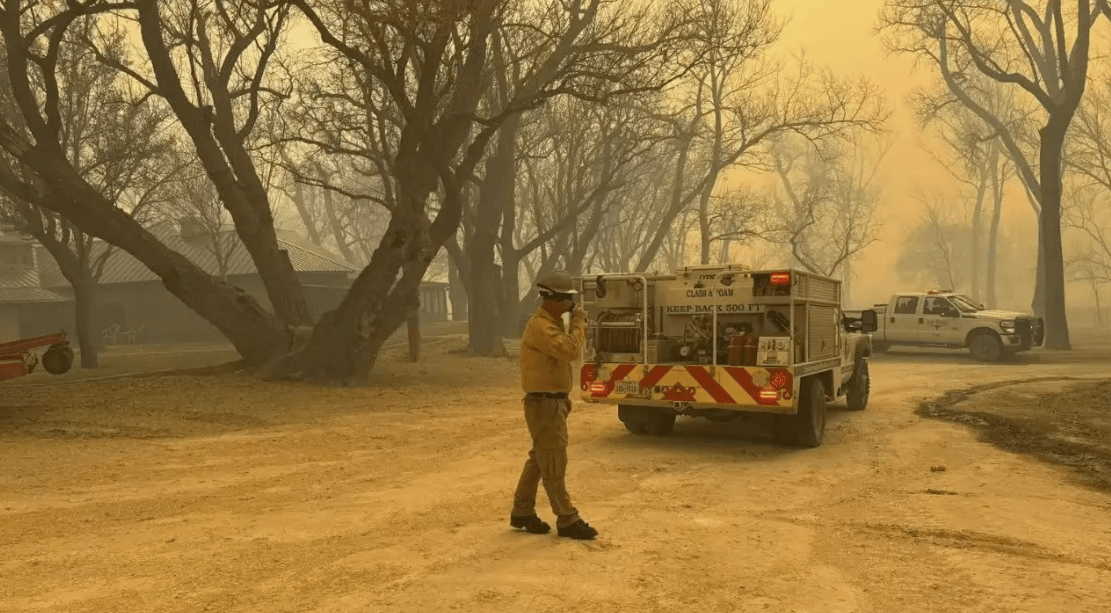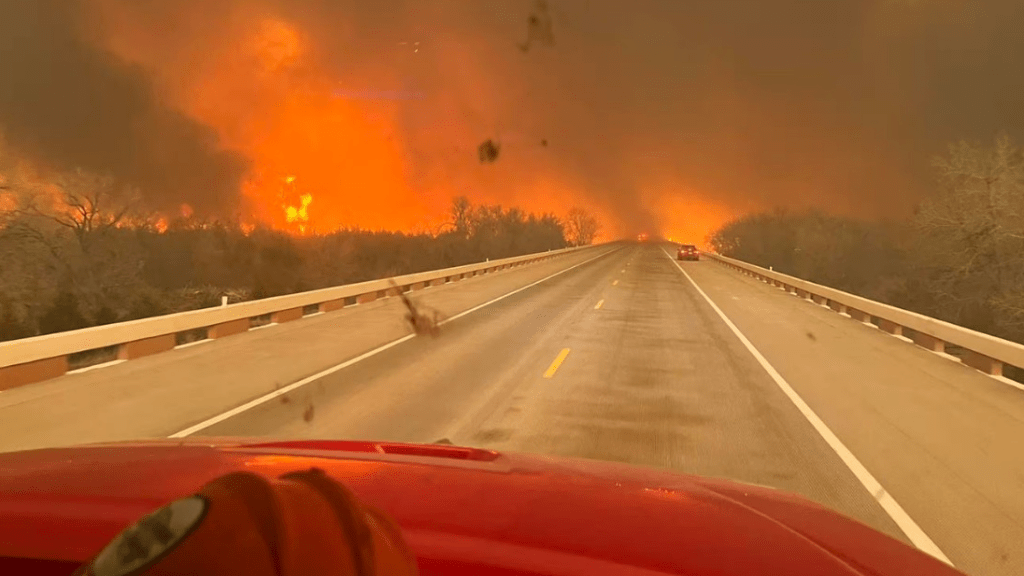United States In Texas Uncontrolled fires According to a CNN meteorologist, the flames are moving at the rate of two football fields per second due to strong winds and very warm temperatures. Texas is seeing one of the largest flames in its history. According to local authorities, at least one person has died as a result of the fires raging in the state’s northern region.
United States In Texas Uncontrolled fires An 83-year-old grandmother died in a fire in the little community of Stinnett, a Hutchinson County official told local media on Wednesday, February 28, adding that at least 20 buildings were damaged.
A hundred kilometers to the east, in the town of Canadian, “several houses burned,” the mayor told CNN, but “fortunately, no one was seriously injured.
Battling the Blaze United States In Texas Uncontrolled fires:
The Smokehouse Creek fire, which is famed for its grasslands, was barely 3 percent contained. The massive fire, which expanded due to strong winds and extremely high temperatures, has already consumed 344,000 hectares. According to CNN meteorologist Chad Myers, the fire is spreading at a rate of two football fields per second.
The five current fires in Texas, including the Smokehouse Creek fire, have consumed more than 404,000 acres. United States In Texas Uncontrolled fires Texas Governor Greg Abbott announced a state of emergency for 60 counties in the southern state on Tuesday.
The National Weather Service in Amarillo, the region’s main city, stated Wednesday that cool temperatures “accompanied by light winds” will assist firefighters battle the fires.
Mobilizing Resources United States In Texas Uncontrolled fires:
In the vast expanse of Texas, a state known for its rugged landscapes and diverse ecosystems, wildfires have long been a natural occurrence. United States In Texas Uncontrolled fires However, in recent years, the intensity and frequency of these fires have escalated, posing significant threats to lives, property, and the environment.
United States In Texas Uncontrolled fires This essay delves into the causes, impacts, and mitigation efforts surrounding wildfires in Texas, aiming to shed light on this pressing issue.

The Causes of Wildfires in Texas:
Wildfires in Texas are often ignited by a variety of factors, both natural and human-induced. One of the primary catalysts is the state’s climate, characterized by hot, dry summers and sporadic rainfall. During periods of drought, vegetation becomes parched and highly flammable, providing ample fuel for wildfires.
United States In Texas Uncontrolled fires Additionally, Texas is prone to strong winds, which can rapidly spread fires across vast areas, making containment efforts even more challenging. Human activities also play a significant role in sparking wildfires. Accidental ignitions from campfires, discarded cigarettes, and equipment malfunctions are common culprits.
United States In Texas Uncontrolled fires Moreover, the expansion of residential areas into wildland-urban interfaces increases the likelihood of human-caused fires, as well as the potential for property damage and loss of life.
Battling the Blaze: The Devastating Impact of Wildfires in Texas
Introduction: The state of Texas, renowned for its vast landscapes and diverse ecosystems, has long been plagued by the menace of wildfires. United States In Texas Uncontrolled fires These infernos, fueled by a combination of dry conditions, strong winds, and human activities, have wreaked havoc on communities, wildlife, and the environment.
In recent years, the frequency and intensity of wildfires in Texas have escalated, posing significant challenges to firefighting agencies, residents, and policymakers alike.
United States In Texas Uncontrolled fires This article delves into the causes, consequences, and efforts to combat wildfires in the Lone Star State, shedding light on the resilience and determination of those on the front lines of these fiery battles.
The Escalating Crisis: Unprecedented Growth of Uncontrolled Fires in Texas
The Causes of Wildfires in Texas: Wildfires in Texas are often ignited by a variety of factors, both natural and human-induced. One of the primary catalysts is the state’s climate, characterized by hot, dry summers and sporadic rainfall.
United States In Texas Uncontrolled fires During periods of drought, vegetation becomes parched and highly flammable, providing ample fuel for wildfires. Additionally, Texas is prone to strong winds, which can rapidly spread fires across vast areas, making containment efforts even more challenging.
Innovation Hub:
United States In Texas Uncontrolled fires Human activities also play a significant role in sparking wildfires. Accidental ignitions from campfires, discarded cigarettes, and equipment malfunctions are common culprits.
Moreover, the expansion of residential areas into wildland-urban interfaces increases the likelihood of human-caused fires, as well as the potential for property damage and loss of life.
Texas stands as a formidable leader in technology and industry within the United States, showcasing a dynamic landscape of innovation and economic prowess. With thriving tech hubs like Austin and Dallas-Fort Worth, Texas has emerged as a magnet for startups, tech giants, and forward-thinking entrepreneurs. The state’s robust infrastructure, favorable business climate, and skilled workforce have fostered an ecosystem conducive to technological advancement and industrial growth.
In addition to its prominence in the tech sector, Texas boasts a diverse industrial base encompassing energy, manufacturing, aerospace, and healthcare. From the oil fields of West Texas to the manufacturing facilities along the Gulf Coast, the state’s industrial footprint spans across multiple sectors, driving economic growth and job creation on a national scale.
Consequences of Wildfires:
The consequences of wildfires in Texas are far-reaching and multifaceted, impacting ecosystems, economies, and communities in profound ways. One of the most immediate consequences is the destruction of natural habitats and biodiversity loss. Fires can decimate forests, grasslands, and wetlands, displacing wildlife and disrupting delicate ecological balances.
In addition to environmental damage, wildfires pose significant threats to human health and safety. The smoke produced by fires contains a toxic mix of pollutants, including particulate matter, carbon monoxide, and volatile organic compounds, which can exacerbate respiratory conditions and pose risks to vulnerable populations. Furthermore, wildfires can result in property damage, evacuation orders, and economic losses for affected communities, straining resources and infrastructure.
The Influence of Climate Change
- Examination of the link between climate change and escalating wildfire risks.
- Impact of rising temperatures, prolonged droughts, and changing precipitation patterns on fire behavior.
- Challenges in adapting to a rapidly changing climate and mitigating future wildfire threats.
Response Strategies and Fire Management Efforts
- Overview of Texas’ firefighting agencies and emergency response protocols.
- Importance of early detection systems and rapid deployment of firefighting resources.
- Challenges faced in coordinating large-scale firefighting operations and managing resources effectively.
Empowering Communities for Resilience
- Importance of community engagement and public education on wildfire preparedness.
- Implementation of fire-resistant building codes and land-use planning strategies in fire-prone areas.
- Strengthening community resilience through the establishment of local response teams and emergency preparedness programs.
Efforts to Combat Wildfires:
Combatting wildfires in Texas requires a coordinated and multi-faceted approach involving various stakeholders, including government agencies, firefighting organizations, and local communities. One of the primary strategies is fire suppression, which involves deploying firefighters, aircraft, and equipment to contain and extinguish wildfires.
These efforts are often hampered by rugged terrain, unpredictable weather conditions, and limited resources, underscoring the need for strategic planning and collaboration.
Assessing the Impact: Human and Environmental Toll of Uncontrolled Fires in Texas
In recent years, there has been a growing emphasis on proactive measures to mitigate the risk of wildfires, including prescribed burning, vegetation management, and public education initiatives. Prescribed burning, also known as controlled burns, involves intentionally igniting fires under controlled conditions to reduce fuel loads and minimize the risk of uncontrolled wildfires. Similarly, vegetation management practices such as thinning forests and creating firebreaks can help limit the spread of fires and protect communities at risk.
Political Influence:
Furthermore, public education and outreach play a crucial role in wildfire prevention and preparedness. By raising awareness about the causes of wildfires, promoting responsible fire behavior, and providing guidance on emergency preparedness, communities can better protect themselves and mitigate the impacts of future fires.

The Role of Climate Change:
United States In Texas Uncontrolled fires Climate change is exacerbating the threat of wildfires in Texas and around the world, amplifying the risk of extreme weather events, such as droughts, heatwaves, and intense storms.
Rising temperatures and changing precipitation patterns are prolonging fire seasons and increasing the frequency of severe wildfires. Moreover, climate-driven factors such as bark beetle infestations and invasive species are further destabilizing ecosystems and fueling fire activity.
Looking Ahead United States In Texas Uncontrolled fires:
Addressing the root causes of climate change is essential for reducing the risk of wildfires and building resilience in vulnerable communities. United States In Texas Uncontrolled fires Transitioning to renewable energy sources, reducing greenhouse gas emissions, and implementing adaptation measures can help mitigate the impacts of climate change and safeguard against future wildfire disasters.
Environmental Wonders:
Texas, celebrated for its expansive terrains and rich ecological diversity, has grappled with the persistent threat of wildfires for decades. These relentless blazes, fueled by a potent mix of arid conditions, gusty winds, and human actions, have inflicted widespread devastation on local communities, wildlife habitats, and natural landscapes.
Mobilizing Response:
In recent times, the frequency and ferocity of wildfires across Texas have surged, presenting formidable challenges for firefighting agencies, residents, and policymakers alike. This article seeks to explore the underlying causes, far-reaching consequences, and ongoing efforts to confront the wildfire crisis in the Lone Star State, highlighting the resilience and unwavering commitment of those battling these infernos on the front lines.
Battling the Blaze:
The root causes of wildfires in Texas are deeply intertwined with the state’s climatic conditions and human activities. Prolonged periods of drought coupled with strong winds create ideal conditions for wildfires to ignite and spread rapidly through dry vegetation.
Assessing the Damage:
United States In Texas Uncontrolled fires Moreover, human actions such as discarded cigarettes, sparks from machinery, and unattended campfires contribute significantly to the ignition of wildfires, particularly in areas where urban development encroaches upon wildland interfaces.
Cultural Diversity:
The impacts of wildfires extend far beyond immediate fire zones, reverberating across ecosystems, economies, and communities. These blazes devastate wildlife habitats, destroy critical vegetation, and disrupt natural processes, leading to long-term ecological damage and loss of biodiversity.
Escalating Threat:
United States In Texas Uncontrolled fires Additionally, wildfires pose grave risks to human health and safety, with smoke inhalation and air pollution exacerbating respiratory conditions and endangering vulnerable populations. Furthermore, the destruction of property, displacement of residents, and economic losses compound the socio-economic toll of wildfires on affected communities.
Conclusion United States In Texas Uncontrolled fires:
United States In Texas Uncontrolled fires As wildfires continue to pose significant challenges in Texas, it is imperative that proactive measures are taken to mitigate their impacts and build resilience. By adopting a multi-faceted approach that combines effective fire management strategies, community preparedness efforts, technological innovations, and collaborative partnerships, Texas can navigate the flames towards a more sustainable future where wildfires are managed as an integral part of the landscape rather than a catastrophic threat.

